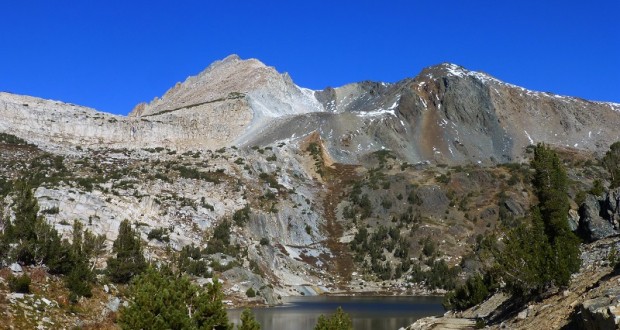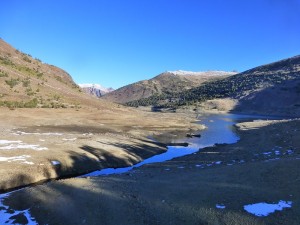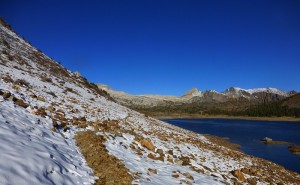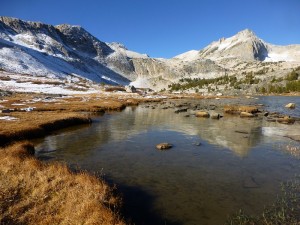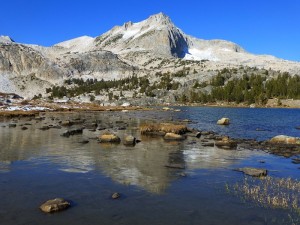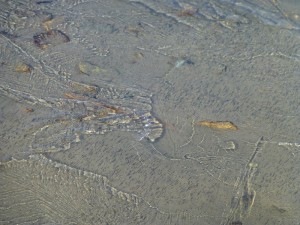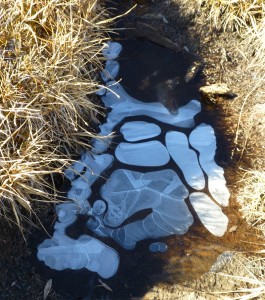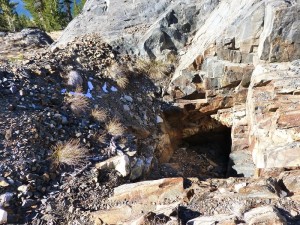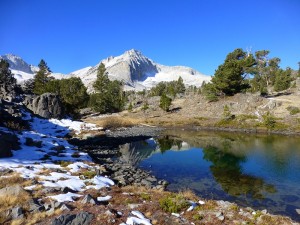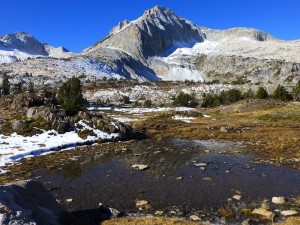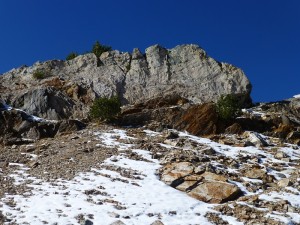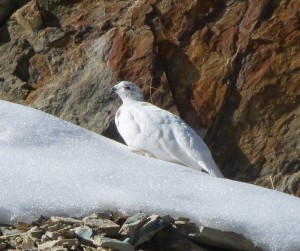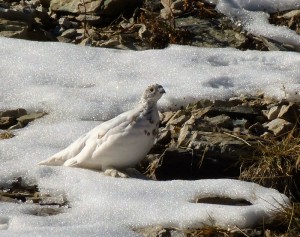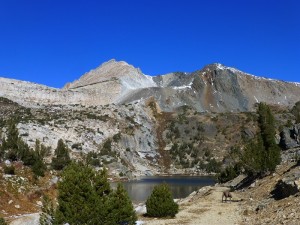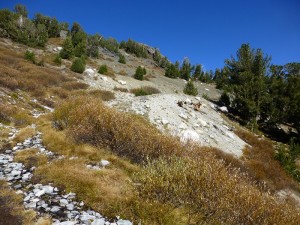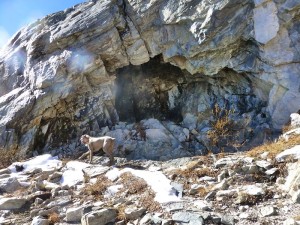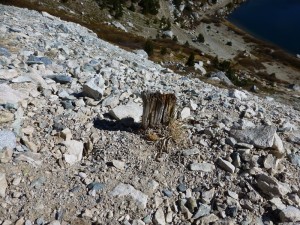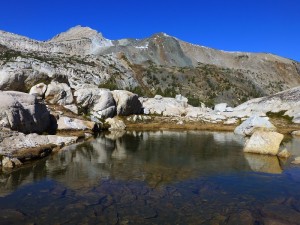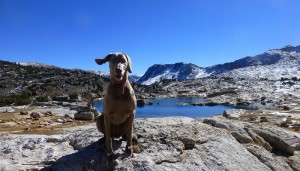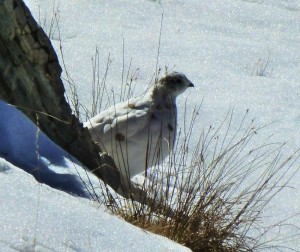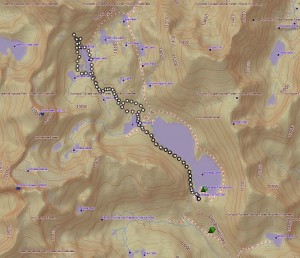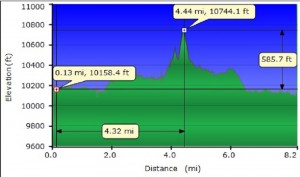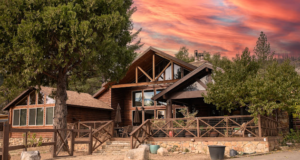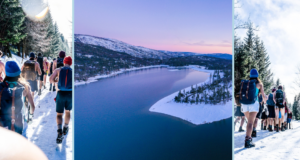I had been looking at a dot on the topog map called the Hess Mine for a few years, walking all around that gorgeous area in the Hoover Wilderness and the 20 Lakes Loop Basin. Sally and I decided that it was time for us to walk around that area and learn more the mine and the people behind it.
Where: Hoover Wilderness, Inyo National Forest
Distance: 8.23 Miles
Difficulty: Moderate to Difficult
Elevational Range: 10,063′ to 10,802′
Date: October 26, 2015
Topographic Quad Maps: Falls Ridge, Buckeye Ridge
Sally and I headed east on Tioga Rd., past the Tioga Pass east entrance to Yosemite National Park, heading north on Saddlebag Lake Rd. up to the Hiker’s parking lot at Saddlebag Lake. We put our goodies in the Bear Box. The restrooms were closed for the season. Sally and I headed across Saddlebag Dam along the west side of the lake. Boy, the lake was low.
I swung along Greenstone Lake. Sometimes the reflections in this lake are magnificent.
Ice still lined the edge of the lake and created very cool artsy photo ops.
I decided to wander the area between the east and west loops of the Twenty Lakes Loop trail. There are lots of old diggings in this area and I love to try and find them. Some are completely collapsed in but some are still open and you need to be careful along the edges of them because the drop-offs are straight down for a long fall. I also like to try to locate remnants of old mining roads. Miners and the supporting people trekked from Lundy to the Bennettville area often and there are multiple ways that they traveled. Some are straightforward because we are using the same routes today on the Twenty Lakes Loop Trail, but others are starting to disappear from history. I did find a mine!
As Sally and I wandered along, we came across small tarns with beautiful reflections.
There is a spot along this trail where we always see some Ptarmagan. Today was no exception and a covey of 6 came up in front of us. They sure blend in well and already had their winter white feathers. Can you spot the well camouflaged Ptarmagan?
Sally and I made it to Steelhead Lake and you can see some of the remains of the tailings from the Hess Mine in this picture at the far side of the lake to the left.
OK, why would I walk this far to see an old mine? Well, I had been seeing this dot on the map for a few years and was curious. When I started researching it, I had conflicting information on exactly where it was. I kind of knew where it was but wanted to find it. The topog maps show it at the top of an old switchback road at the 10,281′ elevation. The U.S. Bureau of Mines shows that it is at the 10,400′ elevation. I found another description that it is located between Steelhead and Shamrock Lakes.
The Hess Mine was primarily a tungsten mine, owned by Gus Hess. Scheelite deposits were explored at the Hess Mine in the 1940s and the only reports that I could find on production were that is was small.
So what is tungsten and what was it used for? It is a hard steel-gray material and if it is made very pure, it retains its hardness. Of all metals in its pure form, tungsten has the highest melting point, the lowest vapor pressure and the highest tensile strength. When tungsten is alloyed with steel, it greatly increases its toughness. It is used as a filament in incandescent light bulbs, X-Ray tubes, tungsten carbide, penetrating projectiles and much more.
It is said that the mine was closed in 1962 but some of the buildings or parts of these buildings are still in use today. The United States Forest Service Wilderness Headquarters at the north end of Saddlebag Lake was one of the living quarters for the mine. Parts of some of the old buildings are now incorporated into the Saddlebag Lake Resort storage building. If you look closely, you can see the remains of an old flume that went from the Lower Conness Lake to supply the Hess Mine.
There is some wonderful history of this area from the son of Gus Ness, August Auggie Hess Jr., born about 1915 who grew up in the Mono Basin and recently celebrated his 100th birthday. From an interview conducted with him in 1991, he tells of what life was like in this area when he was growing up. A link to the full interview is at the end of this blog and I recommend that you check out the book that he wrote, The Kid From Mono Mills. His father, Gus Hess, came to the United States from Switzerland. He started working in San Francisco but caught the gold fever bug and headed inland. He met his wife, who has a well documented Paiute history that goes back to Captain John, one of the last Mono Basin Paiute Chiefs.
I would bet that Mr. August Hess had a very interesting life. I dug up a little information on him but know that I haven’t even scratched the surface, some of the information stated not jiving with other documents. Goldlieb “Gus” Isidor Hess was born September 10, 1886 in Switzerland, immigrating to the United States in 1903, lived in San Francisco for a short time, but was in Lee Vining by 1910. He was naturalized in 1915 and when he filled out his World War I Draft registration on Mary 25, 1917, he says that he was single, an unemployed blacksmith and had a broken leg. By July 1918, he was working as a master mechanic on the Bodie and Benton Railroad and is mentioned as being in charge of the dismantling crews for this railroad. He continued living in the Lee Vining area, with census showing his occupation as mechanic at auto repair and proprietor at a garage. He died December 23, 1959, is wife Lula died January 13, 1967 and they are both buried at Lee Vining.
Gus’s brother, Melchior William Hess was born in Switzerland January 13, 1892 and immigrated to the United States in 1911 per his census information. William also married a Paiute woman named Mildred. William died May 17, 1960 and is buried Lee Vining.
There is one other Hess man living in Lee Vining on the 1910 census, born in Switzerland. Joseph was born about 1886, is a laborer. It says they arrived in the U.S. 1903 in Pennsylvania.
I found a dandy article about the Hess Mine in the Reno Evening Gazette dated January 10, 1942.
“Eckel Discovers Large Tungsten Mine
Emmett Terry Eckel was in Reno Thursday with samples from large tungsten deposits which he recently discovered near Saddlebag Lake, close to Tioga Lake, in Mono County, Calif.
Mr. Eckel said that the deposit was immense and that it took twenty-five claim to cover it.
The matter was referred to the Bridgeport Chronicle-Union recently as follows:
Emmet Terry Eckel, geologist, and construction mining engineer, was over fro Leevining Wednesday and Thursday of this week, taking care of business pertaining to his tungsten interests near Saddlebag Lake.
A graduate from Hidelberg, Germany, Eckel arrived several months ago from Denver, Colo., and started a search for tungsten ore in the Tioga summit area. On the morning of August 13, Mr. Eckel states his efforts were rewarded when he discovered a large body or ore containing one percent tungsten and one percent titanium, the latter a rare mineral used in a steel alloy. The discovery was made about one mile west of Carnegie gardens and about one and one-half miles northeast of Tioga lake and to the left of Saddlebag lake.
According to Eckel, Gus Hess of Hess garage at Leevining, H.E. Crane, Harry Bethel, Ryan Howard, Joe Gregory and Eckel are working on the claims doing location work and with good weather, expect to be finished in about two weeks. It is Eckel’s opinion that when his mine starts operating, it will take care of all the unemployed men in this county.”
When we reached the far north end of the lake, we followed the remains of an old switch back road up the hill.
There were several areas that had significant tailings and I came to the conclusion that all of them were from the Hess Mine and there were several locations in this area where the work was done.
I could see what looked like tailings farther up the hill plus the topog map had it a little higher on the hill, so Sally and I kept heading up. We checked a couple of areas that looked like tailings but they didn’t pan out. We did have a pretty amazing view though. It was a great spot to stop have lunch and admire that view.
It was time for Sally and I to start heading back. I had been admiring the view of the Cascade Lakes and decided to wander though them.
As we walked back through the area where we had seen the Ptarmagans, I spotted one of them keeping an eye on us. Or maybe it knew that we probably wouldn’t make it back up here til spring and in its own way, was letting us know that it will see us in the spring.
Prior Blogs in this Area:
Camping, Fishing and Hiking with Sally at Saddlebag Lake August 26, 2014
Hiking with Sally on the 20 Lakes Basin Loop August 22, 2013
Gaylor Lakes & Great Sierra Mine Hike: Part 1 October 22, 2012
Gaylor Lakes & Great Sierra Mine Hike: Part 2 October 29, 2012
Sources:
Mono Basin Clearing House Interview with August Hess
Hess Mine Information from MineDat.org
Western Mining History Mines in Western United States
Western Mining History Hess Mine
Saddlebag Lake Resort Hess Mine History
USGS Report on Mineral Potential Hoover Wilderness 1979
REACH OUT AND TOUCH NO ONE The Wooden Legacy Of The Bodie & Benton
Reno Evening Gazette, January 10, 1942, Reno, Nevada

